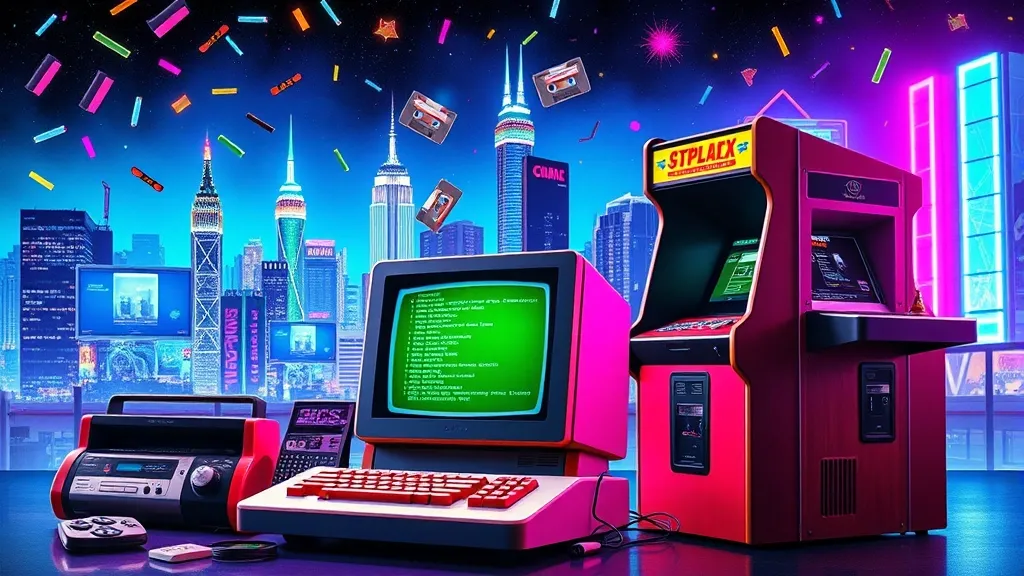The Neon Glow of Innovation: Birth of Personal Computing
Before this wild ride began, computers were huge, noisy beasts that only the big companies and universities could afford. But then, in the late 70s and early 80s, things started to change. Companies like Apple, IBM, and Commodore were like the cool kids on the block, pushing boundaries and making computers accessible to the average Joe. Seriously, how cool is that?
Remember the first time you saw a computer? I do! It was probably something like an Apple II or a Commodore 64. Those machines had this weird charm, with their chunky keyboards and pastel-colored cases. I mean, who wouldn’t want to type on a machine that looked like it belonged in a candy store?
- Apple II: Launched in 1977 but really took off in the 80s, it was one of the first successful mass-produced personal computers. Those graphics? Groundbreaking at the time!
- IBM PC: Released in 1981, it set the standard for what a personal computer should be. It was like the first kid in school to get a smartphone.
- Commodore 64: With its iconic sound chip, it was a gaming powerhouse. I mean, who didn’t love a good game of “Pitfall”?
As personal computing started to catch on, it wasn’t just about work anymore. People were using these machines to play games, write letters, and even create art. This was a revolutionary time when the digital world began to merge with everyday life, and it felt like anything was possible. Imagine being able to create a masterpiece right from your living room—no art school needed!
Of course, the internet wasn’t a thing yet (thank you, dial-up!), but that didn’t stop people from connecting in other ways. Bulletin board systems (BBS) were popping up everywhere, allowing users to chat and share files like it was the coolest club in town. It was a bit chaotic, but honestly, that’s what made it fun. You never knew what you were gonna get!
So, here’s to the 80s—a time when personal computing burst onto the scene and changed everything. It was the dawn of a new era, one that laid the groundwork for the tech-savvy world we live in today. And who knew that behind all that neon glow and noise, innovation was just getting started?
From Commodore to the Cloud: The Tech Giants Rise
As personal computers started popping up in homes like popcorn in a microwave, it was clear that something big was happening. People were no longer just dreaming of the future; they were living it! And let’s be honest, who didn’t feel like a total genius typing away on those early machines? Sure, we spent half our time trying to figure out how to make the printer work, but that just added to the adventure.
Fast forward a bit and enter the 90s. Companies like Microsoft and Apple were starting to flex their muscles. The rivalry between them was like the ultimate tech soap opera. You were either Team Windows or Team Mac, and it felt like a life-or-death situation. I mean, I have friends who still argue about it to this day! But what’s fascinating is how these companies laid the groundwork for everything we use now.
- Microsoft gave us the user-friendly interface that made computers accessible to everyone.
- Apple, with its sleek designs, taught us that tech could be beautiful.
Then, as we rolled into the 2000s, the cloud started to float in. I remember thinking, “Wait, you want me to store my stuff where? In the sky?” It seemed a bit sci-fi, right? But look at us now! Cloud computing has become this essential part of our lives. We’re sharing memes, streaming movies, and saving our work like it’s no big deal.
Today, giants like Amazon and Google are ruling the tech landscape. They’re not just about computers anymore; they’re about everything. Honestly, it’s a bit overwhelming how fast things have evolved. From those clunky Commodore machines to the super-sleek cloud services we rely on, it’s a tech rollercoaster ride that’s still going strong. Buckle up because who knows what’s next!
Dial-Up Dreams: The Internet’s Awkward Adolescence
But let’s be real. Even though it was slow and, let’s face it, a little frustrating, there was something magical about it. I mean, the world was suddenly at our fingertips! I could chat with friends on AOL Instant Messenger (ASL, anyone?), explore weird corners of the web, and even play those super glitchy Flash games. It was a wild time!
Remember those days when the internet would just drop out in the middle of an important chat or, heaven forbid, while downloading a huge file? You’d have to start all over, and it felt like a mini heart attack each time. Not to mention, if someone picked up the phone, there went your connection! It was like living in a soap opera where the stakes were always high. “Mom! I was just about to beat my high score!”
- Chat Rooms: The wild west of the internet. Who knew you could meet so many people who were definitely not who they said they were?
- Geocities: Ah, the neon backgrounds and dancing GIFs—my personal website was a masterpiece of chaos.
- Dial-Up Speeds: Remember when loading a single image could take an eternity? Patience was the name of the game.
Despite all the quirks and frustrations, those dial-up days laid the groundwork for what we have now. It’s funny to look back, but I wouldn’t trade those memories for anything. The internet was awkward, yes, but it was also the beginning of something incredible. We were all learning, growing, and trying to figure out this new digital world together. And honestly, the nostalgia makes me smile. Who knew a series of beeps and clicks would change our lives forever?
Silicon Valley’s Legacy: Echoes of the 80s in Today’s Tech
You can’t really talk about today’s tech without giving a nod to the 80s. Seriously, it’s like trying to do a puzzle without the corner pieces. Silicon Valley, that magical land of startups and wild ideas, really got its groove on back then. I mean, think about it: this is when personal computers started popping up like daisies after a rain. Companies like Apple and IBM were laying the groundwork for everything we now take for granted.
Remember the thrill of firing up a DOS prompt? Okay, maybe that’s just me, but there was something so exciting about the beep of a modem connecting or the smell of a new PC. It’s wild to think that the tech we use today is basically an evolution of those chunky computers and floppy disks. I mean, it’s like looking back at old photos of yourself—sometimes cringeworthy, but also kinda charming.
Fast forward to now, and we’ve got smartphones, cloud computing, and AI doing some pretty mind-blowing stuff. But the foundation was laid in those neon-lit offices where nerds (and I say that with love) were coding late into the night, fueled by pizza and dreams. Silicon Valley was the place where innovation was born, and it still carries that spirit today. The risks people took back then? They paved the way for the bold entrepreneurs we see now, who are still chasing that elusive unicorn.
- Innovation: The 80s was all about pushing boundaries. Today’s startups are just the next iteration of that rebellious spirit.
- Community: Silicon Valley has always been about collaboration. Whether you’re coding in a garage or in a sleek office, it’s that vibe of sharing ideas that keeps it fresh.
- Culture: The quirky, free-spirited culture of the 80s tech scene is still alive and well. Who doesn’t love a good hackathon or a tech meetup with a side of pizza?
So, next time you’re scrolling through your feeds or video chatting with friends, take a moment to appreciate those 80s pioneers. They weren’t just creating tech; they were shaping a culture that still resonates today. It’s like a really cool time capsule that keeps on giving. Who knew that those big, clunky machines would lead us to the sleek devices we can’t live without? I mean, thank you, 80s tech wizards!



